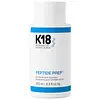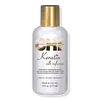What's inside
What's inside
 Key Ingredients
Key Ingredients

No key ingredients
 Benefits
Benefits

 Concerns
Concerns

 Ingredients Side-by-side
Ingredients Side-by-side

Water
Skin ConditioningSodium C14-16 Olefin Sulfonate
CleansingCocamidopropyl Betaine
CleansingSodium Methyl 2-Sulfolaurate
CleansingSodium Lauryl Sulfoacetate
CleansingSh-Oligopeptide-78
Panthenol
Skin ConditioningGlycerin
HumectantSodium Phytate
Guar Hydroxypropyltrimonium Chloride
Skin ConditioningDisodium 2-Sulfolaurate
CleansingCaprylyl Glycol
EmollientCaprylhydroxamic Acid
Benzoic Acid
MaskingCitric Acid
BufferingSodium Hydroxide
BufferingParfum
MaskingLimonene
PerfumingWater, Sodium C14-16 Olefin Sulfonate, Cocamidopropyl Betaine, Sodium Methyl 2-Sulfolaurate, Sodium Lauryl Sulfoacetate, Sh-Oligopeptide-78, Panthenol, Glycerin, Sodium Phytate, Guar Hydroxypropyltrimonium Chloride, Disodium 2-Sulfolaurate, Caprylyl Glycol, Caprylhydroxamic Acid, Benzoic Acid, Citric Acid, Sodium Hydroxide, Parfum, Limonene
Cyclopentasiloxane
EmollientCyclotetrasiloxane
EmollientDimethiconol
EmollientKeratin Amino Acids
Skin ConditioningHydrolyzed Silk
HumectantArgania Spinosa Kernel Oil
EmollientSimmondsia Chinensis Seed Oil
EmollientGlycerin
HumectantHydrolyzed Ceratonia Siliqua Seed Extract
Skin ConditioningZea Mays Starch
AbsorbentGuar Hydroxypropyltrimonium Chloride
Skin ConditioningPolyquaternium-7
C12-15 Alkyl Benzoate
AntimicrobialPhenoxyethanol
PreservativeParfum
MaskingHexyl Cinnamal
PerfumingLinalool
PerfumingButylphenyl Methylpropional
PerfumingGeraniol
PerfumingCitronellol
PerfumingLimonene
PerfumingCitral
PerfumingCyclopentasiloxane, Cyclotetrasiloxane, Dimethiconol, Keratin Amino Acids, Hydrolyzed Silk, Argania Spinosa Kernel Oil, Simmondsia Chinensis Seed Oil, Glycerin, Hydrolyzed Ceratonia Siliqua Seed Extract, Zea Mays Starch, Guar Hydroxypropyltrimonium Chloride, Polyquaternium-7, C12-15 Alkyl Benzoate, Phenoxyethanol, Parfum, Hexyl Cinnamal, Linalool, Butylphenyl Methylpropional, Geraniol, Citronellol, Limonene, Citral
Ingredients Explained
These ingredients are found in both products.
Ingredients higher up in an ingredient list are typically present in a larger amount.
Glycerin is already naturally found in your skin. It helps moisturize and protect your skin.
A study from 2016 found glycerin to be more effective as a humectant than AHAs and hyaluronic acid.
As a humectant, it helps the skin stay hydrated by pulling moisture to your skin. The low molecular weight of glycerin allows it to pull moisture into the deeper layers of your skin.
Hydrated skin improves your skin barrier; Your skin barrier helps protect against irritants and bacteria.
Glycerin has also been found to have antimicrobial and antiviral properties. Due to these properties, glycerin is often used in wound and burn treatments.
In cosmetics, glycerin is usually derived from plants such as soybean or palm. However, it can also be sourced from animals, such as tallow or animal fat.
This ingredient is organic, colorless, odorless, and non-toxic.
Glycerin is the name for this ingredient in American English. British English uses Glycerol/Glycerine.
Learn more about GlycerinThis ingredient is derived from guar gum.
It is a conditioning ingredient, meaning it helps soften skin and hair.
Limonene is a fragrance that adds scent and taste to a formulation.
It's found in the peel oil of citrus fruits and other plants such as lavender and eucalyptus. The scent of limonene is generally described as "sweet citrus".
Limonene acts as an antioxidant, meaning it helps neutralize free radicals.
When exposed to air, oxidized limonene may sensitize the skin. Because of this, limonene is often avoided by people with sensitive skin.
The term 'fragrance' is not regulated in many countries. In many cases, it is up to the brand to define this term. For instance, many brands choose to label themselves as "fragrance-free" because they are not using synthetic fragrances. However, their products may still contain ingredients such as essential oils that are considered a fragrance.
Learn more about LimoneneParfum is a catch-all term for an ingredient or more that is used to give a scent to products.
Also called "fragrance", this ingredient can be a blend of hundreds of chemicals or plant oils. This means every product with "fragrance" or "parfum" in the ingredients list is a different mixture.
For instance, Habanolide is a proprietary trade name for a specific aroma chemical. When used as a fragrance ingredient in cosmetics, most aroma chemicals fall under the broad labeling category of “FRAGRANCE” or “PARFUM” according to EU and US regulations.
The term 'parfum' or 'fragrance' is not regulated in many countries. In many cases, it is up to the brand to define this term.
For instance, many brands choose to label themselves as "fragrance-free" because they are not using synthetic fragrances. However, their products may still contain ingredients such as essential oils that are considered a fragrance by INCI standards.
One example is Calendula flower extract. Calendula is an essential oil that still imparts a scent or 'fragrance'.
Depending on the blend, the ingredients in the mixture can cause allergies and sensitivities on the skin. Some ingredients that are known EU allergens include linalool and citronellol.
Parfum can also be used to mask or cover an unpleasant scent.
The bottom line is: not all fragrances/parfum/ingredients are created equally. If you are worried about fragrances, we recommend taking a closer look at an ingredient. And of course, we always recommend speaking with a professional.
Learn more about Parfum